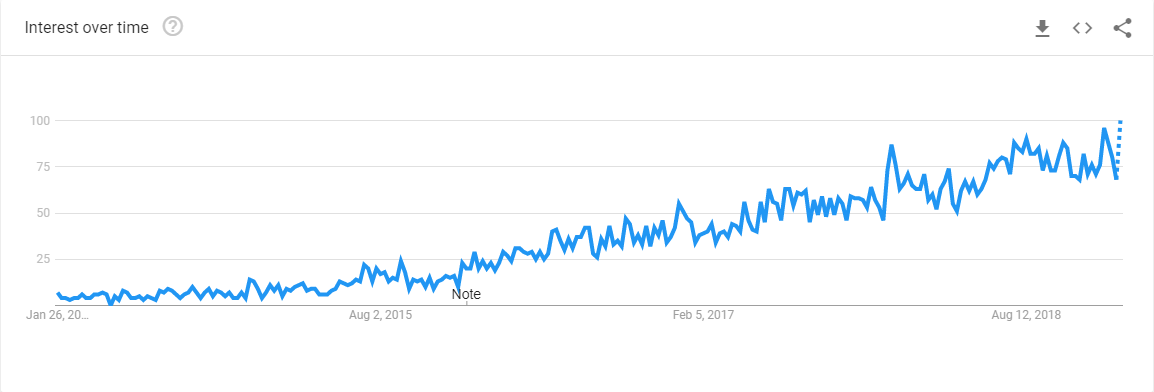It’s easy to have 20/20 vision when you’re identifying what’s worked in the past.
But what about when you’re anticipating healthcare industry trends of the future?
As we begin 2019, we look at 20-years in the healthcare industry—the decade passed and the decade to come—to help you understand which factors have the greatest impact on the growth and success of your hospital or health system.
2009–2019: The last decade of growth
1. Establishment of regional dominance.
Hospitals and health systems that capture the greatest patient market share are those that build reputations as the go-to healthcare providers within their local communities and regions.
With patients primarily looking for healthcare services where they live and work (and increasing their use of localized terms like “ER near me”), local marketing has become an essential component of any successful hospital growth strategy.
“ER near me” (US searches, 2014-2019)

Interest in search terms like “ER near me” has grown considerably over the past five years.
As a result, healthcare providers over the past decade have significantly benefited from tactics like improving their organic rankings for localized search terms (like “pediatrician Santa Clarita” or “pediatrician near me”), targeting their digital ads to local patient populations, and boosting awareness of their healthcare brands in their communities.
2. Promotion of specialty niches.
Primary care and emergency services are crucial healthcare services for any community or regional hospital—but they’re not the leading revenue generators. Research shows that specialty service lines like orthopedics, cardiology, and oncology bring in the most revenue.

Which explains why hospitals and health systems that have successfully marketed themselves as leaders in certain specialty areas have fared well over the past decade.
For example, the Mayo Clinic has built a reputation as one of the “Best Hospitals” in the US for several specialty service lines like cancer care, cardiology, neurology, and orthopedics.
3. Reliance on ancillary services to grow revenue.
With declining medical reimbursements, many healthcare organizations have increased their ancillary service offerings (like lab testing, diagnostic imaging, physical therapy, urgent care, and home health services) to bring in additional revenue from existing patient populations.

Furthermore, increased investment in ancillary services has allowed healthcare organizations to better control their costs, provide patients with more coordinated care, and increase their competitive advantage over other healthcare service providers in their markets.
2019-2029: The next decade of growth
1. Continued local engagement and regional dominance.
Local marketing will be a winning strategy for hospitals and health systems in the next decade.
While patients are changing the way they search for local healthcare services (they’re using “near me” terms less frequently), they’re still driven by local intent.

Patients still want to find the best doctors and treatment facilities in their town, city, or county first, which means they’re going to respond to localized marketing.
As a result, local marketing will continue to be a mainstay for effective hospital growth planning in the decade ahead.
2. Focus on efficiency over volume.
In the past, hospitals and health systems focused their efforts on expanding their patient volume to increase revenue.
However, there has been a major shift to value-based care in recent years—programs that incentivize quality of care and improved patient outcomes over the sheer volume of healthcare services rendered.
And with the increased use of data to streamline everything from marketing and business operations to the delivery of care, healthcare providers are learning how to improve their operational efficiency, which is improving results and lowering costs.

The most successful hospitals and health systems in the next decade will be those that think long-term...not just how they can get more patients through the door, but how they can deliver the highest value to patients at the best economy of scale.
3. Expand remote and virtual care.
Telehealth is becoming a staple of American healthcare.
More than three-quarters of hospitals in the US are either using or implementing telehealth, and the majority of US states have enacted “parity” laws that require health insurers to cover telehealth services in the same way they cover in-person healthcare services.
As healthcare consumers begin demanding greater convenience from their healthcare providers (care when and where they want it) and providers look for more ways to cut down on costs, telehealth is slated to be one of the industry’s biggest trends to watch.

From primary to specialty care, virtual healthcare is permeating the traditional healthcare system, creating greater flexibility for both patients and providers during a time of clinician shortages and rising healthcare costs.
4. Prioritization of the patient experience.
Healthcare consumerism isn’t a new concept.
Industry experts have been talking about this cultural shift for years now.
Healthcare consumerism refers to patients paying more attention to value and acting more like retail shoppers in the way they select healthcare services.
However, what is new is the way hospital executives are responding to the trend—they’re making more concerted efforts to deliver patient-focused care.
A recent survey showed that 65% of healthcare executives have changed how they define “patient-centered care” over the past five years.
They say that it means more than just involving patients more in their care decisions—it now also means improving patients’ access to care, delivering more coordinated care, and ensuring patients have the educational resources they need to make important healthcare decisions.

The hospital executives surveyed also said the highest priority for delivering patient-centered care is to improve patient satisfaction, and they said they’re using the following approaches to create better experiences and outcomes for patients:
- Mobile apps to engage and interact with patients (97%)
- Technology (94.4%)
- Electronic health records (88.9%)
- Apps for providers (80.6%)
- Wearable devices (47.2%)
In the future, the most successful healthcare providers will be those who do more than just realize changing shifts in patient demand—they will be those who take real action within their organizations to meet those demands and create more seamless experiences for patients.
Want to work with a healthcare digital marketing partner that truly understands what it takes to succeed in your industry?



